Project Management: Musical Festival Planning and Risk Analysis
VerifiedAdded on 2023/01/19
|12
|1813
|93
Project
AI Summary
This project delves into the intricacies of project management within the context of organizing a musical festival. It begins with an introduction to project management and its significance, followed by an exploration of three key project management methodologies: Critical Path Method (CPM), Lean, and Scrum, each tailored to different project needs. The project then constructs a network diagram to visualize project activities and their dependencies, providing a clear roadmap for execution. A comprehensive stakeholder analysis is conducted, identifying and categorizing stakeholders based on their roles, interests, and influence. Finally, the project undertakes a detailed risk analysis, identifying and assessing five potential risks, along with proposed mitigation strategies. The project concludes by summarizing the findings and emphasizing the importance of effective project management for achieving organizational goals. The references section provides a list of sources used in the project.
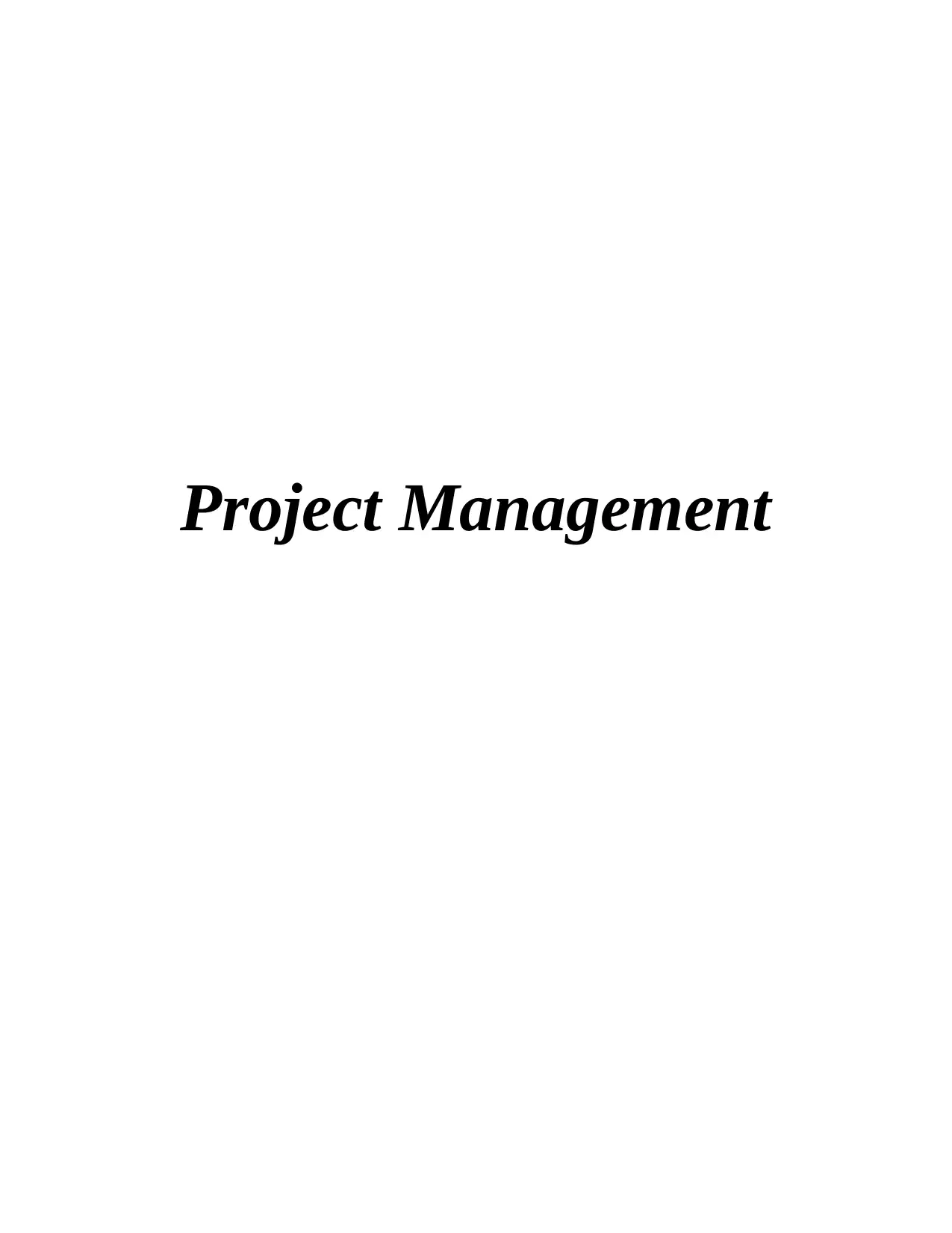
Project Management
Paraphrase This Document
Need a fresh take? Get an instant paraphrase of this document with our AI Paraphraser
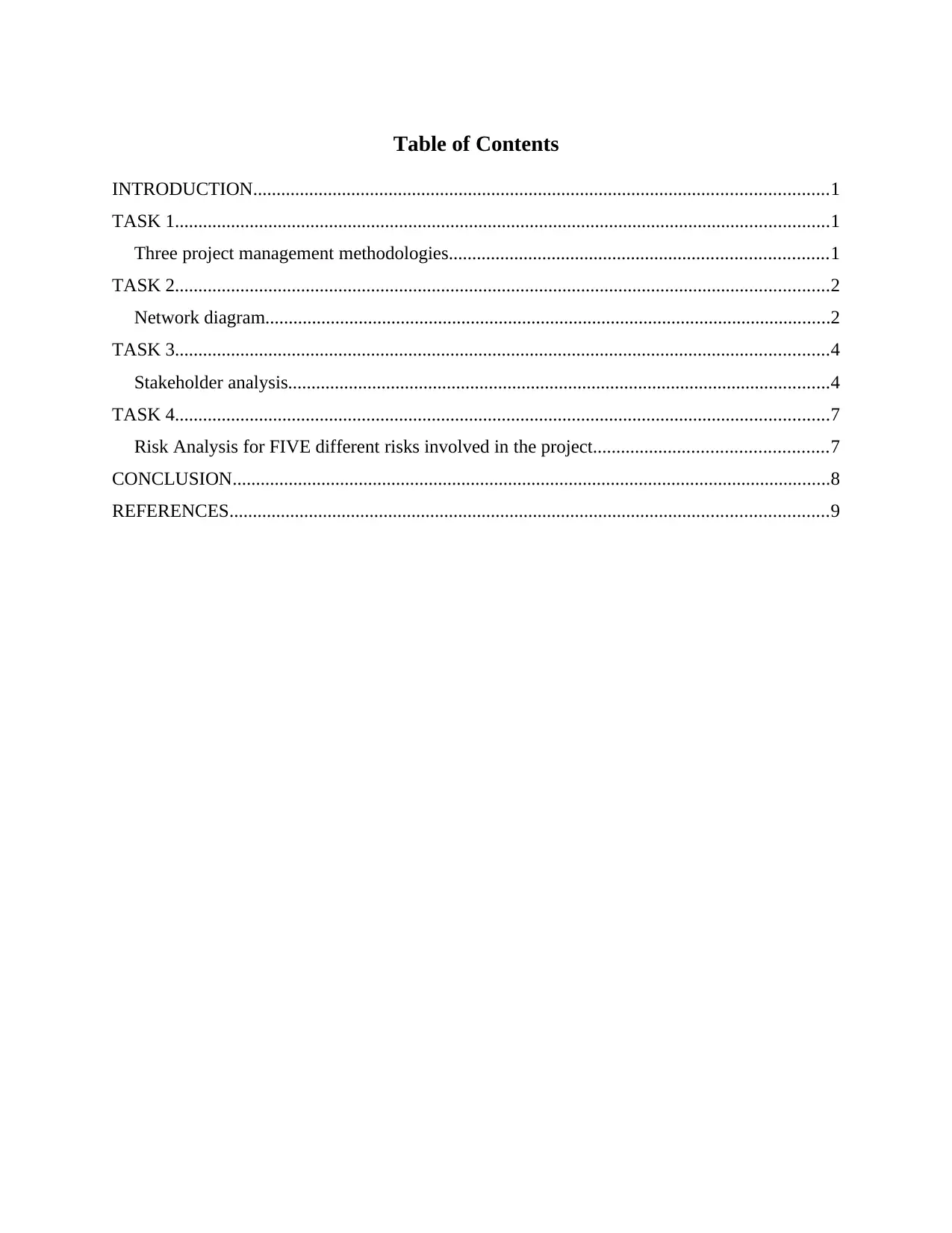
Table of Contents
INTRODUCTION...........................................................................................................................1
TASK 1............................................................................................................................................1
Three project management methodologies.................................................................................1
TASK 2............................................................................................................................................2
Network diagram.........................................................................................................................2
TASK 3............................................................................................................................................4
Stakeholder analysis....................................................................................................................4
TASK 4............................................................................................................................................7
Risk Analysis for FIVE different risks involved in the project..................................................7
CONCLUSION................................................................................................................................8
REFERENCES................................................................................................................................9
INTRODUCTION...........................................................................................................................1
TASK 1............................................................................................................................................1
Three project management methodologies.................................................................................1
TASK 2............................................................................................................................................2
Network diagram.........................................................................................................................2
TASK 3............................................................................................................................................4
Stakeholder analysis....................................................................................................................4
TASK 4............................................................................................................................................7
Risk Analysis for FIVE different risks involved in the project..................................................7
CONCLUSION................................................................................................................................8
REFERENCES................................................................................................................................9
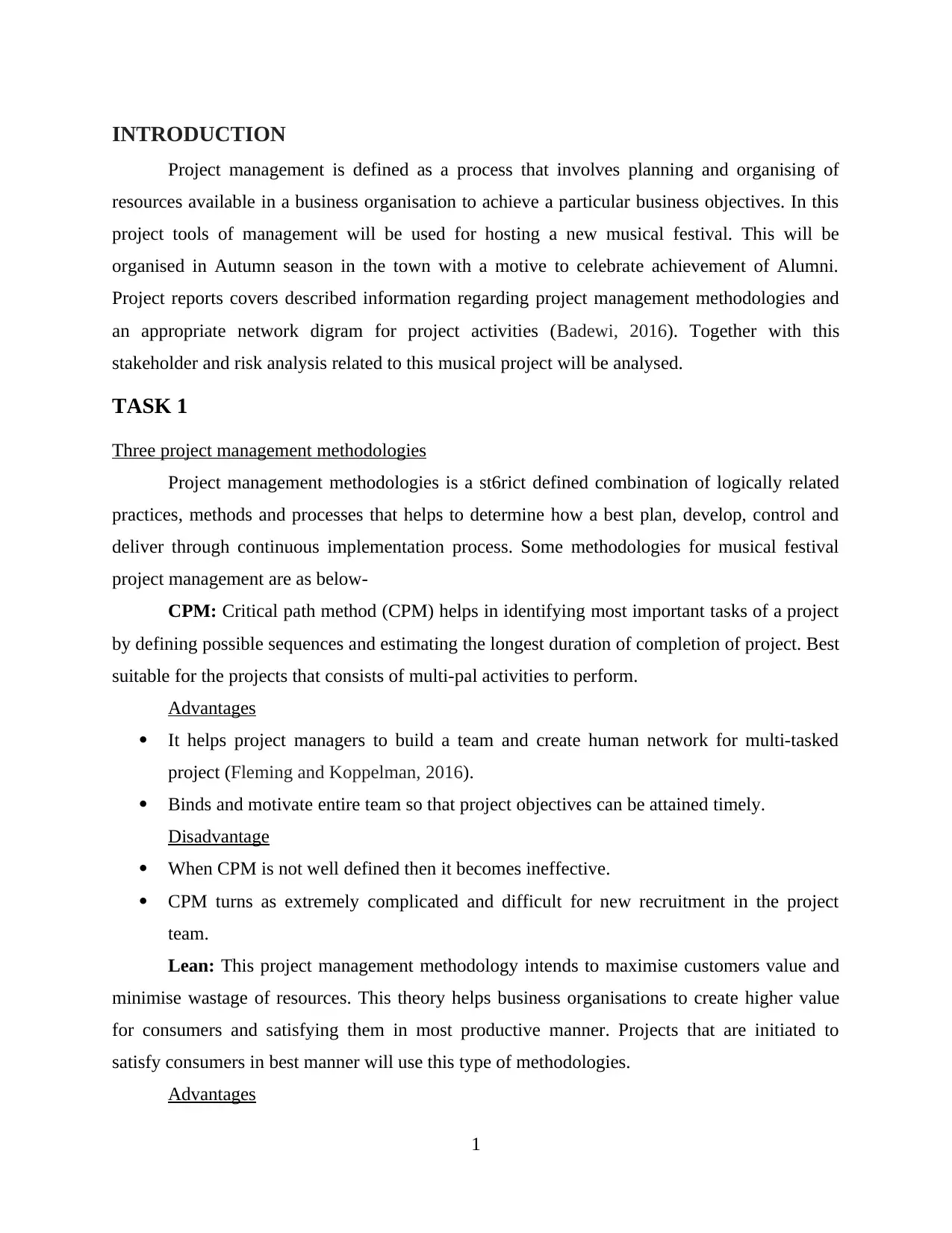
INTRODUCTION
Project management is defined as a process that involves planning and organising of
resources available in a business organisation to achieve a particular business objectives. In this
project tools of management will be used for hosting a new musical festival. This will be
organised in Autumn season in the town with a motive to celebrate achievement of Alumni.
Project reports covers described information regarding project management methodologies and
an appropriate network digram for project activities (Badewi, 2016). Together with this
stakeholder and risk analysis related to this musical project will be analysed.
TASK 1
Three project management methodologies
Project management methodologies is a st6rict defined combination of logically related
practices, methods and processes that helps to determine how a best plan, develop, control and
deliver through continuous implementation process. Some methodologies for musical festival
project management are as below-
CPM: Critical path method (CPM) helps in identifying most important tasks of a project
by defining possible sequences and estimating the longest duration of completion of project. Best
suitable for the projects that consists of multi-pal activities to perform.
Advantages
It helps project managers to build a team and create human network for multi-tasked
project (Fleming and Koppelman, 2016).
Binds and motivate entire team so that project objectives can be attained timely.
Disadvantage
When CPM is not well defined then it becomes ineffective.
CPM turns as extremely complicated and difficult for new recruitment in the project
team.
Lean: This project management methodology intends to maximise customers value and
minimise wastage of resources. This theory helps business organisations to create higher value
for consumers and satisfying them in most productive manner. Projects that are initiated to
satisfy consumers in best manner will use this type of methodologies.
Advantages
1
Project management is defined as a process that involves planning and organising of
resources available in a business organisation to achieve a particular business objectives. In this
project tools of management will be used for hosting a new musical festival. This will be
organised in Autumn season in the town with a motive to celebrate achievement of Alumni.
Project reports covers described information regarding project management methodologies and
an appropriate network digram for project activities (Badewi, 2016). Together with this
stakeholder and risk analysis related to this musical project will be analysed.
TASK 1
Three project management methodologies
Project management methodologies is a st6rict defined combination of logically related
practices, methods and processes that helps to determine how a best plan, develop, control and
deliver through continuous implementation process. Some methodologies for musical festival
project management are as below-
CPM: Critical path method (CPM) helps in identifying most important tasks of a project
by defining possible sequences and estimating the longest duration of completion of project. Best
suitable for the projects that consists of multi-pal activities to perform.
Advantages
It helps project managers to build a team and create human network for multi-tasked
project (Fleming and Koppelman, 2016).
Binds and motivate entire team so that project objectives can be attained timely.
Disadvantage
When CPM is not well defined then it becomes ineffective.
CPM turns as extremely complicated and difficult for new recruitment in the project
team.
Lean: This project management methodology intends to maximise customers value and
minimise wastage of resources. This theory helps business organisations to create higher value
for consumers and satisfying them in most productive manner. Projects that are initiated to
satisfy consumers in best manner will use this type of methodologies.
Advantages
1
⊘ This is a preview!⊘
Do you want full access?
Subscribe today to unlock all pages.

Trusted by 1+ million students worldwide
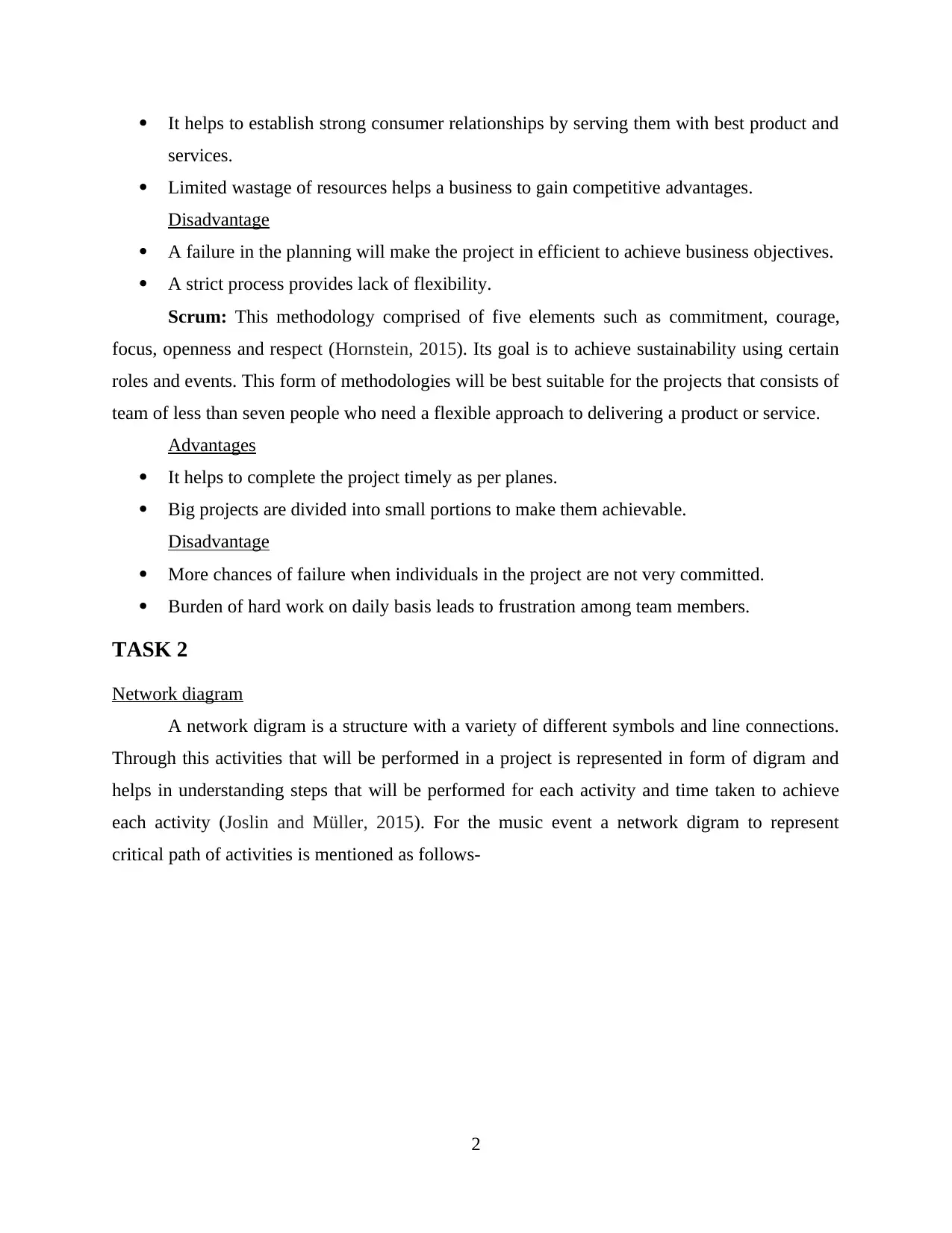
It helps to establish strong consumer relationships by serving them with best product and
services.
Limited wastage of resources helps a business to gain competitive advantages.
Disadvantage
A failure in the planning will make the project in efficient to achieve business objectives.
A strict process provides lack of flexibility.
Scrum: This methodology comprised of five elements such as commitment, courage,
focus, openness and respect (Hornstein, 2015). Its goal is to achieve sustainability using certain
roles and events. This form of methodologies will be best suitable for the projects that consists of
team of less than seven people who need a flexible approach to delivering a product or service.
Advantages
It helps to complete the project timely as per planes.
Big projects are divided into small portions to make them achievable.
Disadvantage
More chances of failure when individuals in the project are not very committed.
Burden of hard work on daily basis leads to frustration among team members.
TASK 2
Network diagram
A network digram is a structure with a variety of different symbols and line connections.
Through this activities that will be performed in a project is represented in form of digram and
helps in understanding steps that will be performed for each activity and time taken to achieve
each activity (Joslin and Müller, 2015). For the music event a network digram to represent
critical path of activities is mentioned as follows-
2
services.
Limited wastage of resources helps a business to gain competitive advantages.
Disadvantage
A failure in the planning will make the project in efficient to achieve business objectives.
A strict process provides lack of flexibility.
Scrum: This methodology comprised of five elements such as commitment, courage,
focus, openness and respect (Hornstein, 2015). Its goal is to achieve sustainability using certain
roles and events. This form of methodologies will be best suitable for the projects that consists of
team of less than seven people who need a flexible approach to delivering a product or service.
Advantages
It helps to complete the project timely as per planes.
Big projects are divided into small portions to make them achievable.
Disadvantage
More chances of failure when individuals in the project are not very committed.
Burden of hard work on daily basis leads to frustration among team members.
TASK 2
Network diagram
A network digram is a structure with a variety of different symbols and line connections.
Through this activities that will be performed in a project is represented in form of digram and
helps in understanding steps that will be performed for each activity and time taken to achieve
each activity (Joslin and Müller, 2015). For the music event a network digram to represent
critical path of activities is mentioned as follows-
2
Paraphrase This Document
Need a fresh take? Get an instant paraphrase of this document with our AI Paraphraser
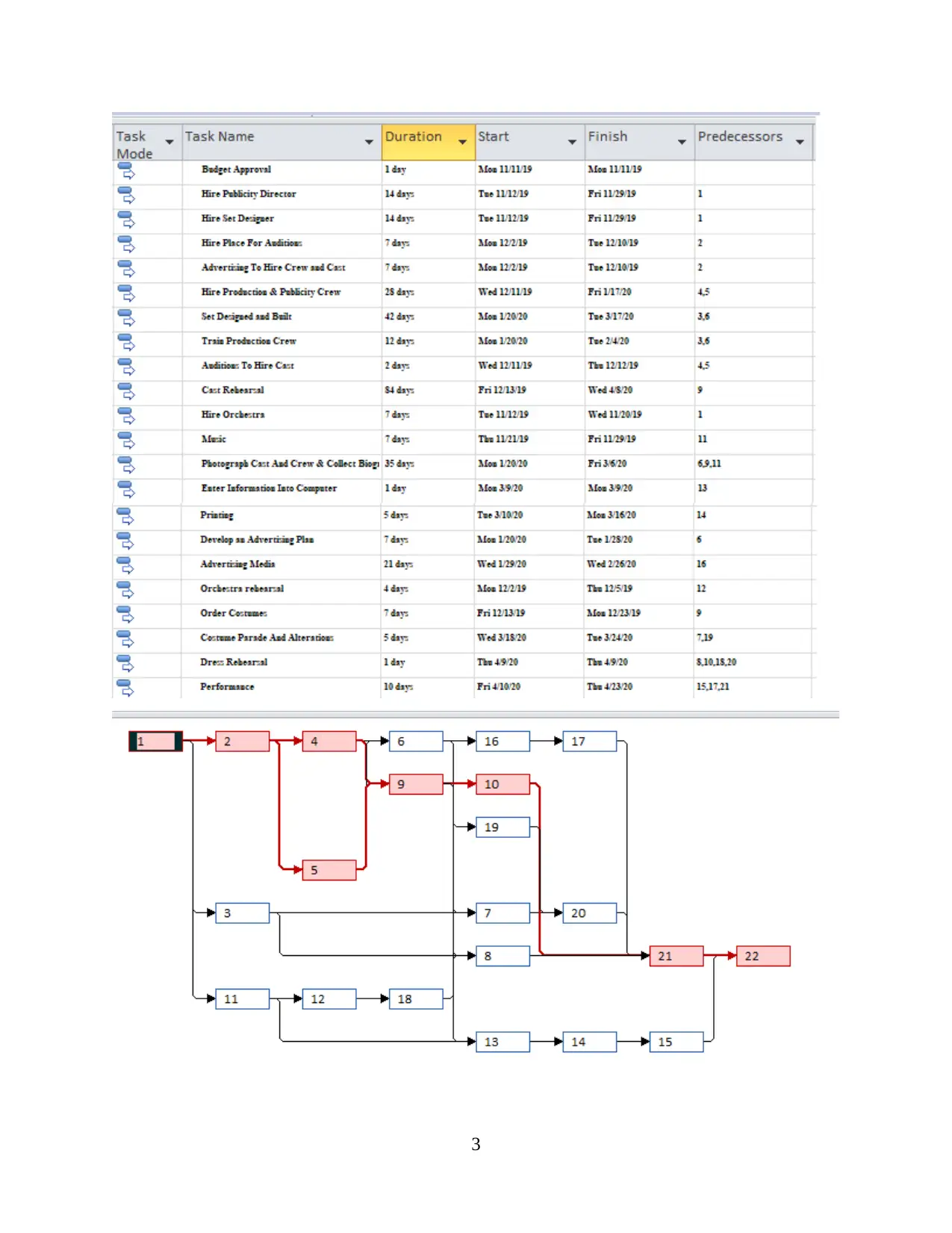
3
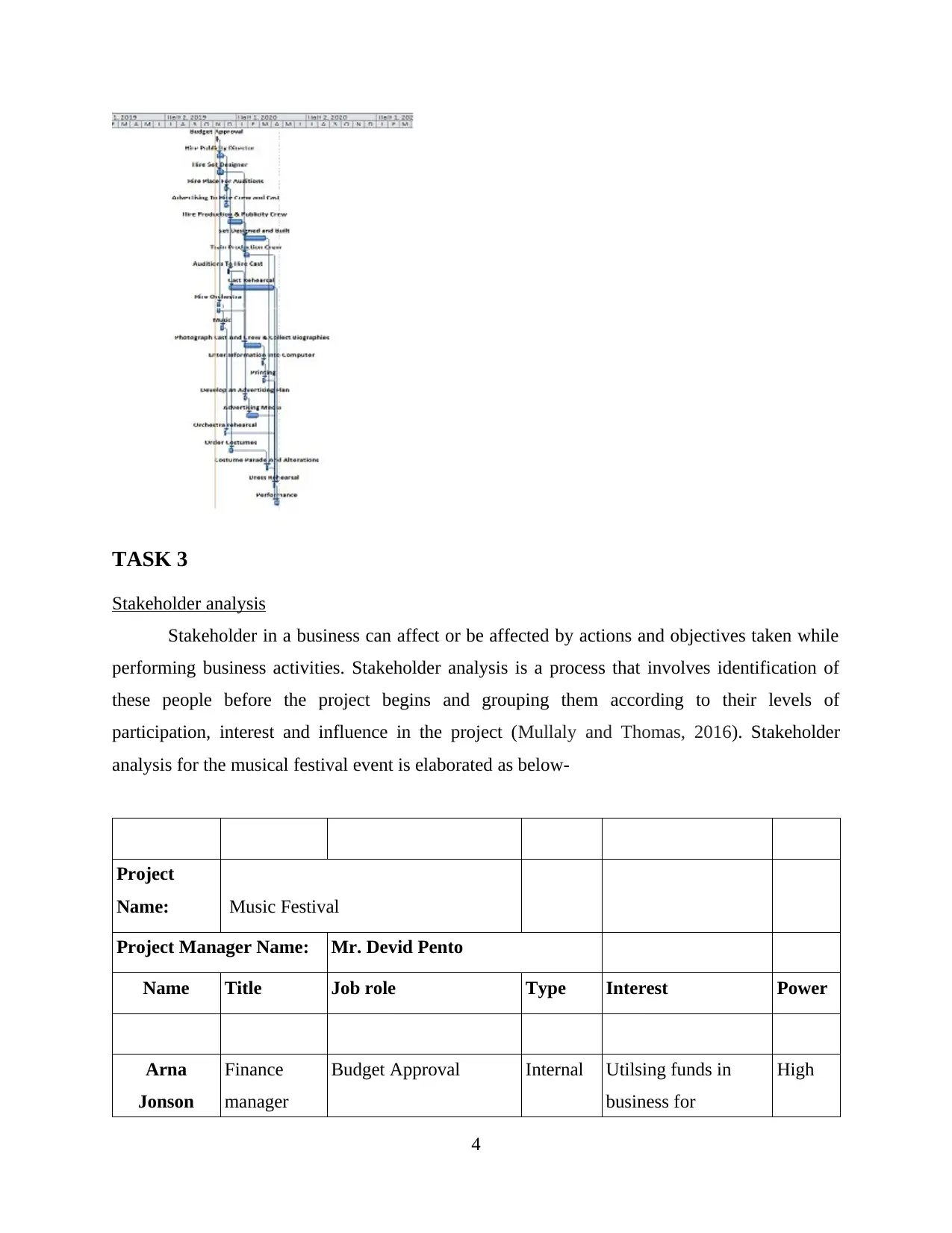
TASK 3
Stakeholder analysis
Stakeholder in a business can affect or be affected by actions and objectives taken while
performing business activities. Stakeholder analysis is a process that involves identification of
these people before the project begins and grouping them according to their levels of
participation, interest and influence in the project (Mullaly and Thomas, 2016). Stakeholder
analysis for the musical festival event is elaborated as below-
Project
Name: Music Festival
Project Manager Name: Mr. Devid Pento
Name Title Job role Type Interest Power
Arna
Jonson
Finance
manager
Budget Approval Internal Utilsing funds in
business for
High
4
Stakeholder analysis
Stakeholder in a business can affect or be affected by actions and objectives taken while
performing business activities. Stakeholder analysis is a process that involves identification of
these people before the project begins and grouping them according to their levels of
participation, interest and influence in the project (Mullaly and Thomas, 2016). Stakeholder
analysis for the musical festival event is elaborated as below-
Project
Name: Music Festival
Project Manager Name: Mr. Devid Pento
Name Title Job role Type Interest Power
Arna
Jonson
Finance
manager
Budget Approval Internal Utilsing funds in
business for
High
4
⊘ This is a preview!⊘
Do you want full access?
Subscribe today to unlock all pages.

Trusted by 1+ million students worldwide
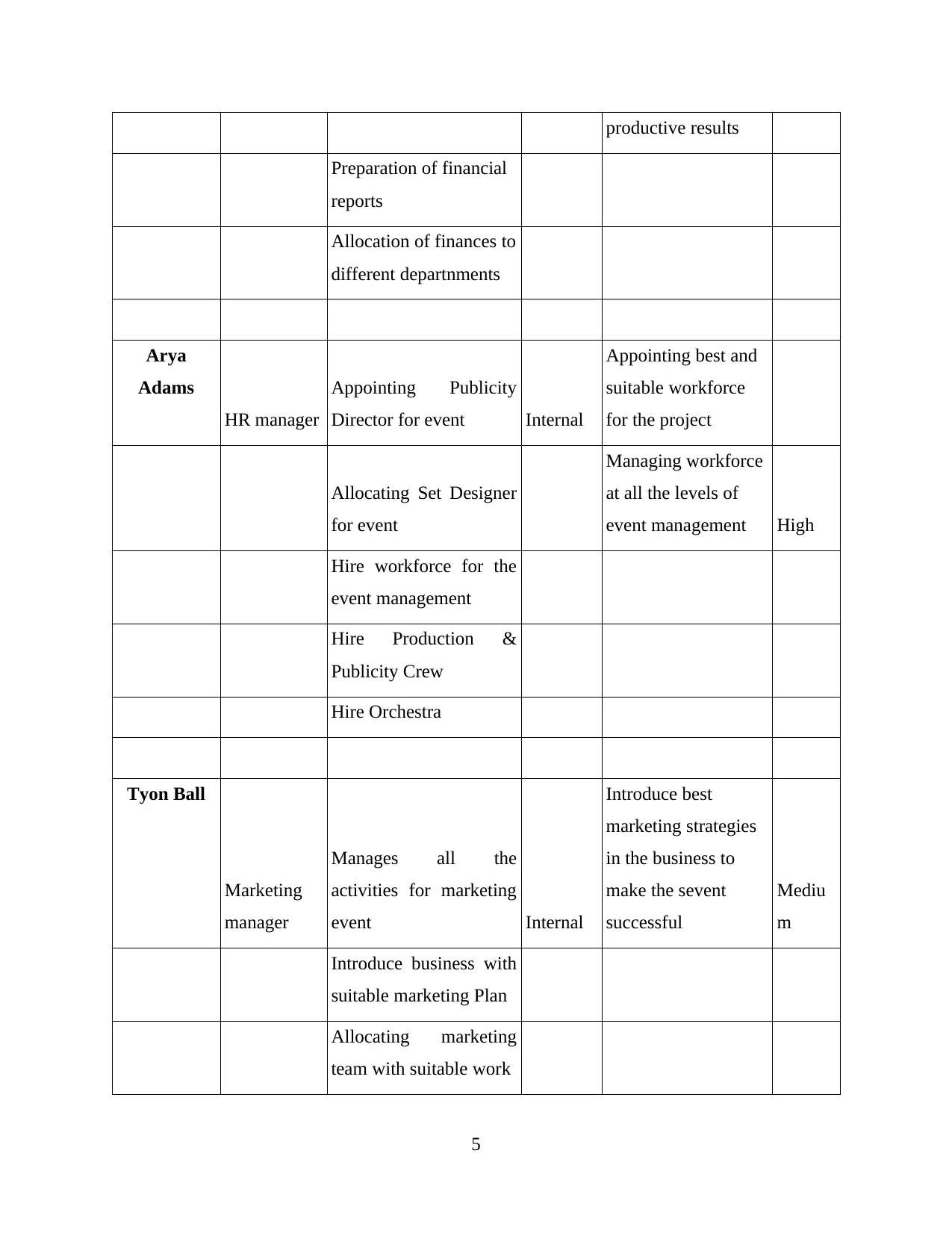
productive results
Preparation of financial
reports
Allocation of finances to
different departnments
Arya
Adams
HR manager
Appointing Publicity
Director for event Internal
Appointing best and
suitable workforce
for the project
Allocating Set Designer
for event
Managing workforce
at all the levels of
event management High
Hire workforce for the
event management
Hire Production &
Publicity Crew
Hire Orchestra
Tyon Ball
Marketing
manager
Manages all the
activities for marketing
event Internal
Introduce best
marketing strategies
in the business to
make the sevent
successful
Mediu
m
Introduce business with
suitable marketing Plan
Allocating marketing
team with suitable work
5
Preparation of financial
reports
Allocation of finances to
different departnments
Arya
Adams
HR manager
Appointing Publicity
Director for event Internal
Appointing best and
suitable workforce
for the project
Allocating Set Designer
for event
Managing workforce
at all the levels of
event management High
Hire workforce for the
event management
Hire Production &
Publicity Crew
Hire Orchestra
Tyon Ball
Marketing
manager
Manages all the
activities for marketing
event Internal
Introduce best
marketing strategies
in the business to
make the sevent
successful
Mediu
m
Introduce business with
suitable marketing Plan
Allocating marketing
team with suitable work
5
Paraphrase This Document
Need a fresh take? Get an instant paraphrase of this document with our AI Paraphraser
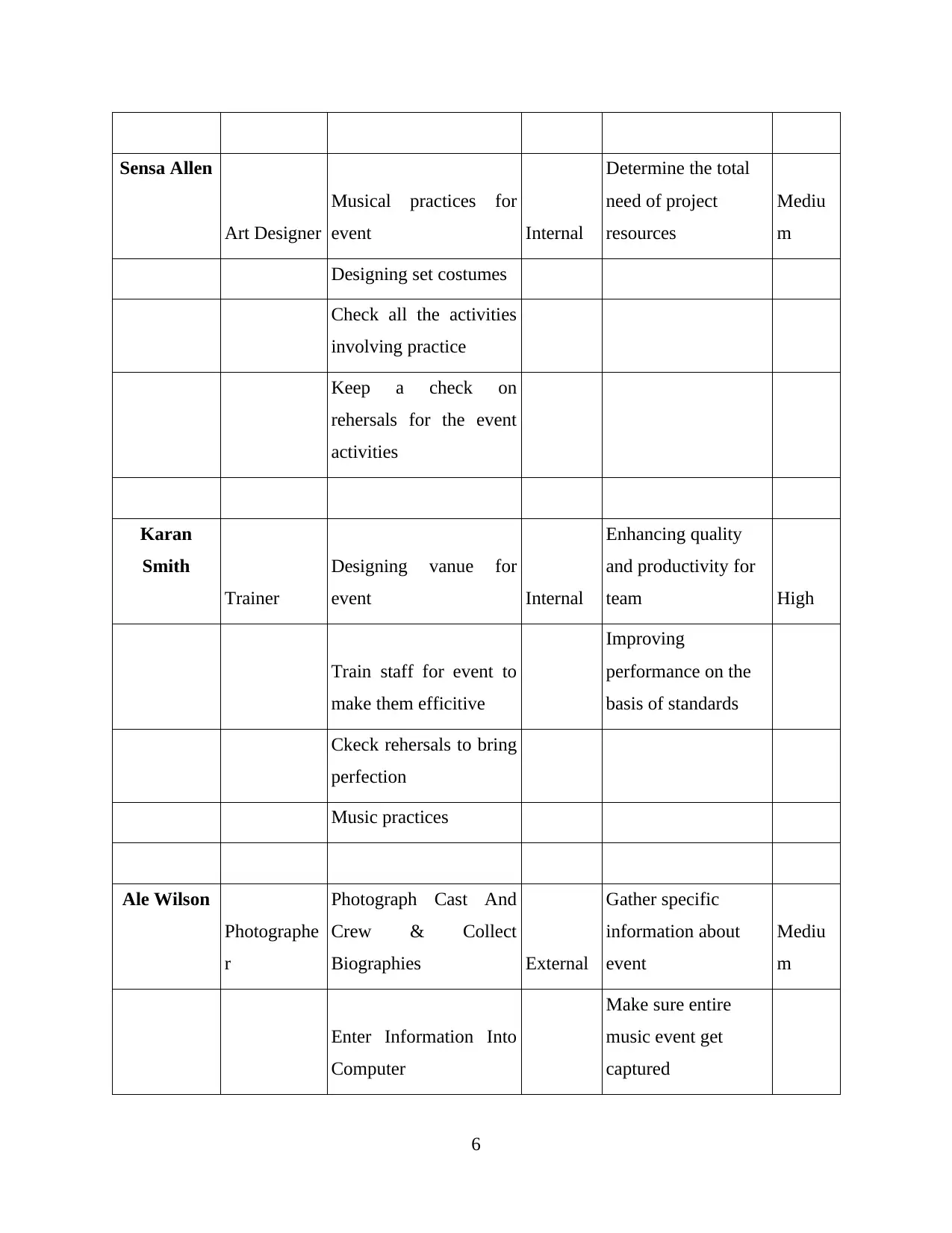
Sensa Allen
Art Designer
Musical practices for
event Internal
Determine the total
need of project
resources
Mediu
m
Designing set costumes
Check all the activities
involving practice
Keep a check on
rehersals for the event
activities
Karan
Smith
Trainer
Designing vanue for
event Internal
Enhancing quality
and productivity for
team High
Train staff for event to
make them efficitive
Improving
performance on the
basis of standards
Ckeck rehersals to bring
perfection
Music practices
Ale Wilson
Photographe
r
Photograph Cast And
Crew & Collect
Biographies External
Gather specific
information about
event
Mediu
m
Enter Information Into
Computer
Make sure entire
music event get
captured
6
Art Designer
Musical practices for
event Internal
Determine the total
need of project
resources
Mediu
m
Designing set costumes
Check all the activities
involving practice
Keep a check on
rehersals for the event
activities
Karan
Smith
Trainer
Designing vanue for
event Internal
Enhancing quality
and productivity for
team High
Train staff for event to
make them efficitive
Improving
performance on the
basis of standards
Ckeck rehersals to bring
perfection
Music practices
Ale Wilson
Photographe
r
Photograph Cast And
Crew & Collect
Biographies External
Gather specific
information about
event
Mediu
m
Enter Information Into
Computer
Make sure entire
music event get
captured
6
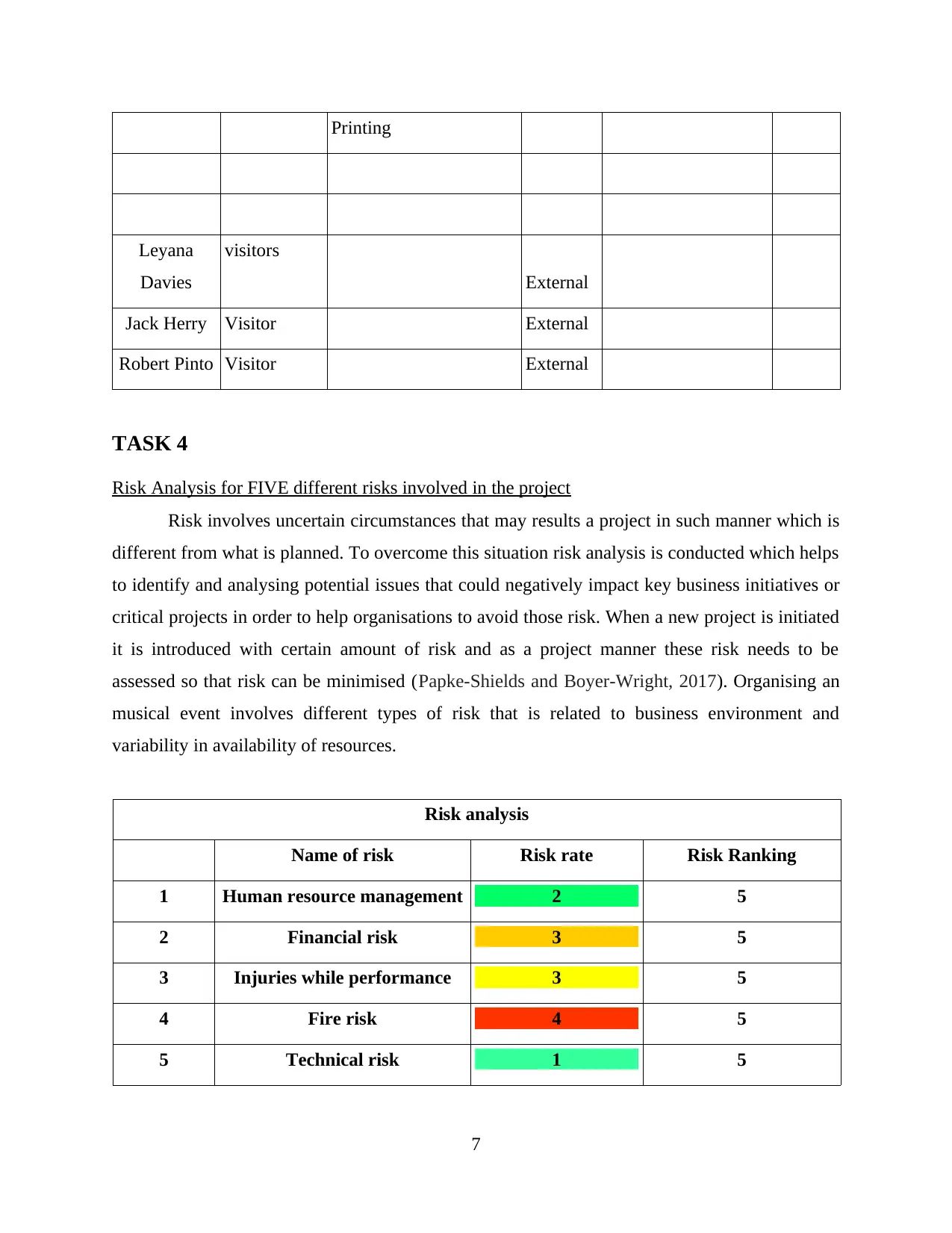
Printing
Leyana
Davies
visitors
External
Jack Herry Visitor External
Robert Pinto Visitor External
TASK 4
Risk Analysis for FIVE different risks involved in the project
Risk involves uncertain circumstances that may results a project in such manner which is
different from what is planned. To overcome this situation risk analysis is conducted which helps
to identify and analysing potential issues that could negatively impact key business initiatives or
critical projects in order to help organisations to avoid those risk. When a new project is initiated
it is introduced with certain amount of risk and as a project manner these risk needs to be
assessed so that risk can be minimised (Papke-Shields and Boyer-Wright, 2017). Organising an
musical event involves different types of risk that is related to business environment and
variability in availability of resources.
Risk analysis
Name of risk Risk rate Risk Ranking
1 Human resource management 2 5
2 Financial risk 3 5
3 Injuries while performance 3 5
4 Fire risk 4 5
5 Technical risk 1 5
7
Leyana
Davies
visitors
External
Jack Herry Visitor External
Robert Pinto Visitor External
TASK 4
Risk Analysis for FIVE different risks involved in the project
Risk involves uncertain circumstances that may results a project in such manner which is
different from what is planned. To overcome this situation risk analysis is conducted which helps
to identify and analysing potential issues that could negatively impact key business initiatives or
critical projects in order to help organisations to avoid those risk. When a new project is initiated
it is introduced with certain amount of risk and as a project manner these risk needs to be
assessed so that risk can be minimised (Papke-Shields and Boyer-Wright, 2017). Organising an
musical event involves different types of risk that is related to business environment and
variability in availability of resources.
Risk analysis
Name of risk Risk rate Risk Ranking
1 Human resource management 2 5
2 Financial risk 3 5
3 Injuries while performance 3 5
4 Fire risk 4 5
5 Technical risk 1 5
7
⊘ This is a preview!⊘
Do you want full access?
Subscribe today to unlock all pages.

Trusted by 1+ million students worldwide
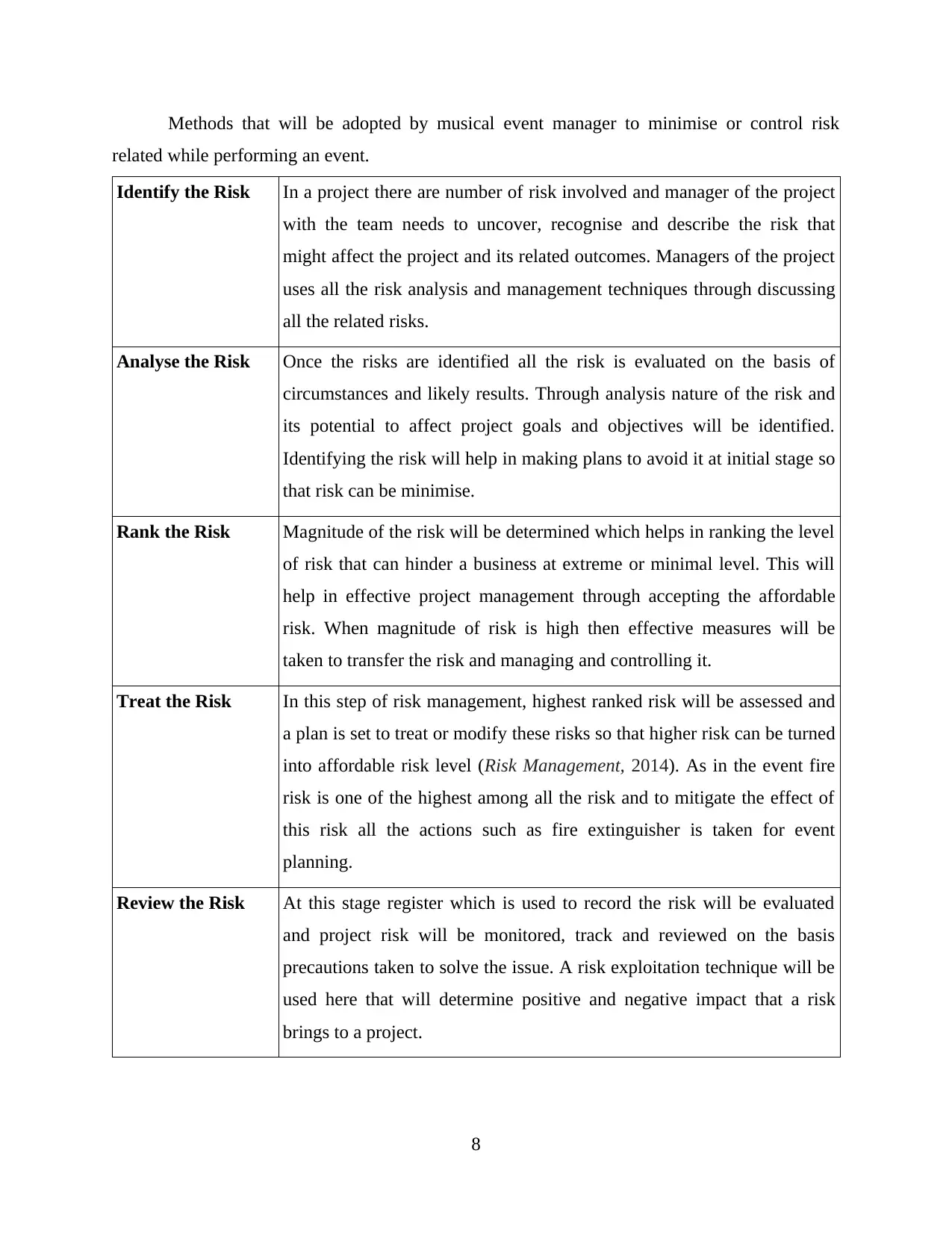
Methods that will be adopted by musical event manager to minimise or control risk
related while performing an event.
Identify the Risk In a project there are number of risk involved and manager of the project
with the team needs to uncover, recognise and describe the risk that
might affect the project and its related outcomes. Managers of the project
uses all the risk analysis and management techniques through discussing
all the related risks.
Analyse the Risk Once the risks are identified all the risk is evaluated on the basis of
circumstances and likely results. Through analysis nature of the risk and
its potential to affect project goals and objectives will be identified.
Identifying the risk will help in making plans to avoid it at initial stage so
that risk can be minimise.
Rank the Risk Magnitude of the risk will be determined which helps in ranking the level
of risk that can hinder a business at extreme or minimal level. This will
help in effective project management through accepting the affordable
risk. When magnitude of risk is high then effective measures will be
taken to transfer the risk and managing and controlling it.
Treat the Risk In this step of risk management, highest ranked risk will be assessed and
a plan is set to treat or modify these risks so that higher risk can be turned
into affordable risk level (Risk Management, 2014). As in the event fire
risk is one of the highest among all the risk and to mitigate the effect of
this risk all the actions such as fire extinguisher is taken for event
planning.
Review the Risk At this stage register which is used to record the risk will be evaluated
and project risk will be monitored, track and reviewed on the basis
precautions taken to solve the issue. A risk exploitation technique will be
used here that will determine positive and negative impact that a risk
brings to a project.
8
related while performing an event.
Identify the Risk In a project there are number of risk involved and manager of the project
with the team needs to uncover, recognise and describe the risk that
might affect the project and its related outcomes. Managers of the project
uses all the risk analysis and management techniques through discussing
all the related risks.
Analyse the Risk Once the risks are identified all the risk is evaluated on the basis of
circumstances and likely results. Through analysis nature of the risk and
its potential to affect project goals and objectives will be identified.
Identifying the risk will help in making plans to avoid it at initial stage so
that risk can be minimise.
Rank the Risk Magnitude of the risk will be determined which helps in ranking the level
of risk that can hinder a business at extreme or minimal level. This will
help in effective project management through accepting the affordable
risk. When magnitude of risk is high then effective measures will be
taken to transfer the risk and managing and controlling it.
Treat the Risk In this step of risk management, highest ranked risk will be assessed and
a plan is set to treat or modify these risks so that higher risk can be turned
into affordable risk level (Risk Management, 2014). As in the event fire
risk is one of the highest among all the risk and to mitigate the effect of
this risk all the actions such as fire extinguisher is taken for event
planning.
Review the Risk At this stage register which is used to record the risk will be evaluated
and project risk will be monitored, track and reviewed on the basis
precautions taken to solve the issue. A risk exploitation technique will be
used here that will determine positive and negative impact that a risk
brings to a project.
8
Paraphrase This Document
Need a fresh take? Get an instant paraphrase of this document with our AI Paraphraser
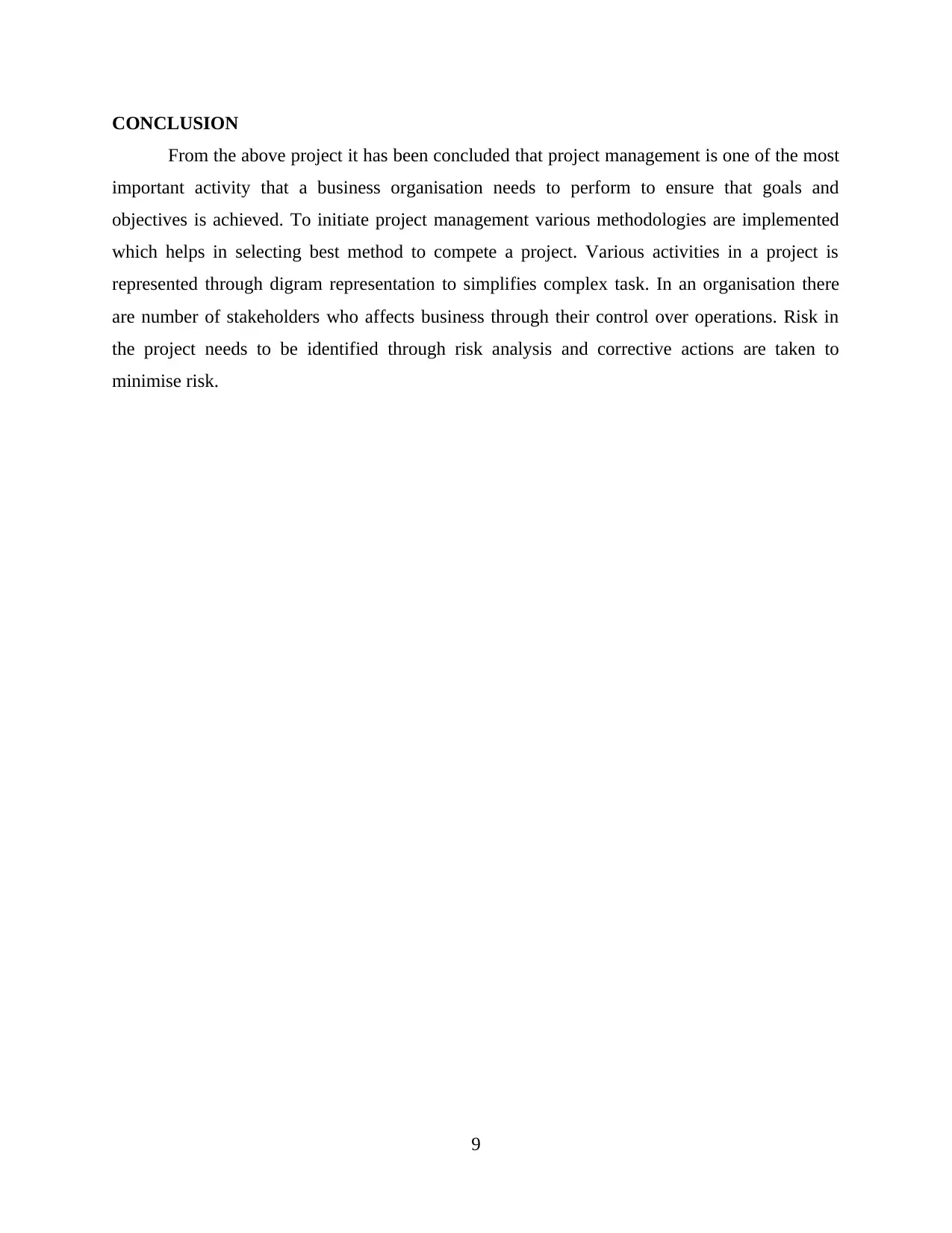
CONCLUSION
From the above project it has been concluded that project management is one of the most
important activity that a business organisation needs to perform to ensure that goals and
objectives is achieved. To initiate project management various methodologies are implemented
which helps in selecting best method to compete a project. Various activities in a project is
represented through digram representation to simplifies complex task. In an organisation there
are number of stakeholders who affects business through their control over operations. Risk in
the project needs to be identified through risk analysis and corrective actions are taken to
minimise risk.
9
From the above project it has been concluded that project management is one of the most
important activity that a business organisation needs to perform to ensure that goals and
objectives is achieved. To initiate project management various methodologies are implemented
which helps in selecting best method to compete a project. Various activities in a project is
represented through digram representation to simplifies complex task. In an organisation there
are number of stakeholders who affects business through their control over operations. Risk in
the project needs to be identified through risk analysis and corrective actions are taken to
minimise risk.
9
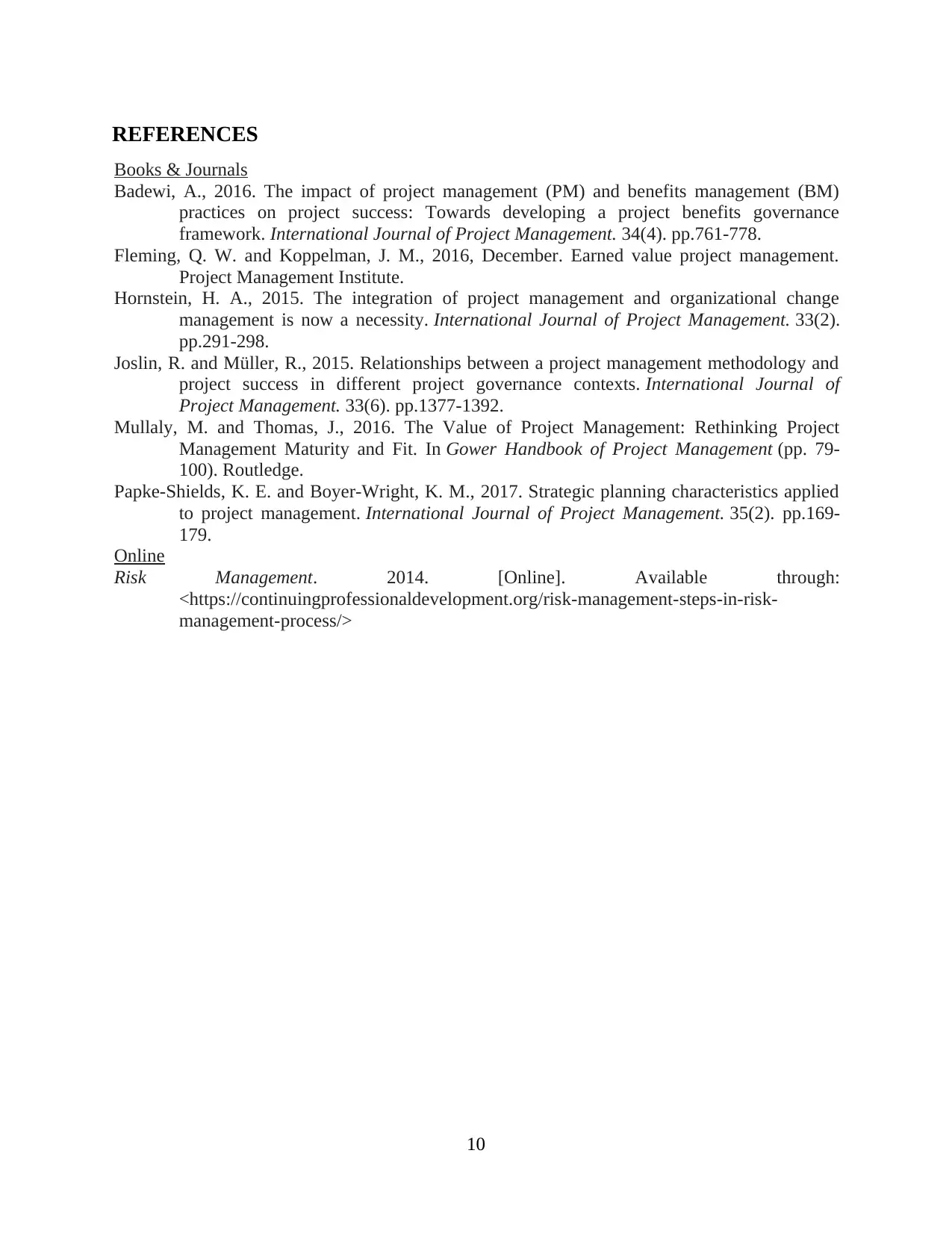
REFERENCES
Books & Journals
Badewi, A., 2016. The impact of project management (PM) and benefits management (BM)
practices on project success: Towards developing a project benefits governance
framework. International Journal of Project Management. 34(4). pp.761-778.
Fleming, Q. W. and Koppelman, J. M., 2016, December. Earned value project management.
Project Management Institute.
Hornstein, H. A., 2015. The integration of project management and organizational change
management is now a necessity. International Journal of Project Management. 33(2).
pp.291-298.
Joslin, R. and Müller, R., 2015. Relationships between a project management methodology and
project success in different project governance contexts. International Journal of
Project Management. 33(6). pp.1377-1392.
Mullaly, M. and Thomas, J., 2016. The Value of Project Management: Rethinking Project
Management Maturity and Fit. In Gower Handbook of Project Management (pp. 79-
100). Routledge.
Papke-Shields, K. E. and Boyer-Wright, K. M., 2017. Strategic planning characteristics applied
to project management. International Journal of Project Management. 35(2). pp.169-
179.
Online
Risk Management. 2014. [Online]. Available through:
<https://continuingprofessionaldevelopment.org/risk-management-steps-in-risk-
management-process/>
10
Books & Journals
Badewi, A., 2016. The impact of project management (PM) and benefits management (BM)
practices on project success: Towards developing a project benefits governance
framework. International Journal of Project Management. 34(4). pp.761-778.
Fleming, Q. W. and Koppelman, J. M., 2016, December. Earned value project management.
Project Management Institute.
Hornstein, H. A., 2015. The integration of project management and organizational change
management is now a necessity. International Journal of Project Management. 33(2).
pp.291-298.
Joslin, R. and Müller, R., 2015. Relationships between a project management methodology and
project success in different project governance contexts. International Journal of
Project Management. 33(6). pp.1377-1392.
Mullaly, M. and Thomas, J., 2016. The Value of Project Management: Rethinking Project
Management Maturity and Fit. In Gower Handbook of Project Management (pp. 79-
100). Routledge.
Papke-Shields, K. E. and Boyer-Wright, K. M., 2017. Strategic planning characteristics applied
to project management. International Journal of Project Management. 35(2). pp.169-
179.
Online
Risk Management. 2014. [Online]. Available through:
<https://continuingprofessionaldevelopment.org/risk-management-steps-in-risk-
management-process/>
10
⊘ This is a preview!⊘
Do you want full access?
Subscribe today to unlock all pages.

Trusted by 1+ million students worldwide
1 out of 12
Related Documents
Your All-in-One AI-Powered Toolkit for Academic Success.
+13062052269
info@desklib.com
Available 24*7 on WhatsApp / Email
![[object Object]](/_next/static/media/star-bottom.7253800d.svg)
Unlock your academic potential
Copyright © 2020–2025 A2Z Services. All Rights Reserved. Developed and managed by ZUCOL.





